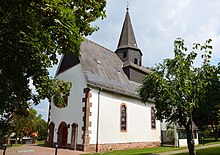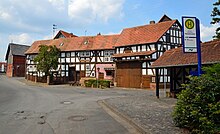Großseelheim
|
Großseelheim
City of Kirchhain
Coordinates: 50 ° 49 ′ 3 ″ N , 8 ° 51 ′ 47 ″ E
|
|
|---|---|
| Height : | 198 (195-210) m above sea level NHN |
| Area : | 9.51 km² |
| Residents : | 1865 (Jun. 30, 2017) |
| Population density : | 196 inhabitants / km² |
| Incorporation : | July 1, 1974 |
| Postal code : | 35274 |
| Area code : | 06422 |
Großseelheim is a village in the central Hessian district of Marburg-Biedenkopf and the largest district of Kirchhain .
Geographical location
Großseelheim is located between the towns of Marburg and Kirchhain on the western edge of the district of Kirchhain on a plateau that slightly towers above the Ohm valley in the Amöneburg Basin . The flood retention basin Kirchhain / Ohm is located east of the village to protect the villages on the river Ohm .
history
According to recent research, Großseelheim was first mentioned in 779 AD in a deed of donation from Argoz and his wife to the Fulda monastery under the first Fulda abbot Sturmi . On November 30, 920, Seelheim was the location of Heinrich I's court assembly . In the Middle Ages, the seat of the Bailiff of the Teutonic Order was located in the village. In 1766 the Teutonic Order sold its existing rights to Großseelheim to Hesse.
Territorial reform
On July 1, 1974, until then independent municipality Großseelheim was in the course of administrative reform in Hesse powerful state law in the city Kirchhain incorporated .
Place name
The name of the village has Franconian origins. First, the place "Seleheim" was written. A distinction between Großseelheim and Kleinseelheim was not made until the middle of the 13th century.
Territorial history and administration
The following list gives an overview of the territories in which Großseelheim was located and the administrative units to which it was subordinate:
- before 1567 Holy Roman Empire , Seelheim court (Großseelheim, Kleinseelheim and Schönbach belonged to the Seelheim court) 3 ⁄ 4 German order property , 1 ⁄ 4 fuldisches fief
- from 1567 Holy Roman Empire , Landgraviate Hessen-Marburg , Marburg Office , Seelheim Court
- from 1592: Holy Roman Empire, Landgraviate Hessen-Marburg, Marburg Office, Seelheim Court
- 1604–1648: Holy Roman Empire, disputed between Landgraviate Hessen-Darmstadt and Landgraviate Hessen-Kassel ( Hessian War ), Marburg Office, Seelheim Court
- from 1648: Holy Roman Empire, Landgraviate Hessen-Kassel, Marburg Office, Seelheim Court
- from 1767: Holy Roman Empire, Landgraviate Hessen-Kassel, Kirchhain office , Seelheim court
- from 1803: Holy Roman Empire, Electorate of Hesse , Kirchhain office, Seelheim court
- from 1806: Electorate of Hesse, Kirchhain office, Seelheim court
- 1807–1813: Kingdom of Westphalia , department of Werra , district of Marburg , canton of Amöneburg
- from 1815: German Confederation , Electorate of Hesse, Kirchhain office, Seelheim court
- from 1821: German Confederation, Electorate of Hesse, Province of Upper Hesse , District of Kirchhain (separation of justice ( Justice Office Kirchhain ) and administration)
- from 1848: German Confederation, Electorate of Hesse, Marburg district
- from 1851: German Confederation, Electorate of Hesse, Province of Upper Hesse, Kirchhain district
- from 1867: North German Confederation , Kingdom of Prussia , Province of Hessen-Nassau , Administrative Region of Kassel , District of Kirchhain
- from 1918: German Empire, Free State of Prussia , Province of Hessen-Nassau, Administrative District of Kassel, District of Kirchhain
- from 1932: German Empire, Free State of Prussia , Province of Hessen-Nassau, Administrative Region of Kassel, District of Marburg
- from 1944: German Empire, Free State of Prussia, Province of Kurhessen , District of Marburg
- from 1945: American occupation zone , Greater Hesse , Kassel administrative district, Marburg district
- from 1949: Federal Republic of Germany , State of Hesse , Kassel district, Marburg district
- 1974: Federal Republic of Germany, State of Hesse, Kassel district, Marburg-Biedenkopf district
- On July 1, 1974, the community Großseelheim was incorporated as a district in the city of Kirchhain.
- from 1981: Federal Republic of Germany, State of Hesse, Gießen district, Marburg-Biedenkopf district
Courts since 1821
With an edict of June 29, 1821, administration and justice were separated in Kurhessen. Now judicial offices were responsible for the first instance jurisdiction, the administration was taken over by the districts. The Kirchhain district was responsible for the administration and the Kirchhain Justice Office as the court of first instance for Großseelheim. The Supreme Court was the Higher Appeal Court in Kassel . The higher court of Marburg was subordinate to the province of Upper Hesse. It was the second instance for the Kirchhain Justice Office.
After the annexation of Kurhessen by Prussia, the justice office became the royal Prussian district court in Kirchhain . In June 1867, a royal ordinance was issued that reorganized the court system in the areas that belonged to the former Electorate of Hesse. The previous judicial authorities were to be repealed and replaced by local courts in the first, district courts in the second and an appeal court in the third instance. In the course of this, on September 1, 1867, the previous judicial office was renamed the Kirchhain District Court. The courts of the higher authorities were the Marburg District Court and the Kassel Court of Appeal .
With the entry into force of the Courts Constitution Act of 1879, the district court continued to exist under his name. In the Federal Republic of Germany, the superordinate instances are the Marburg Regional Court , the Frankfurt am Main Higher Regional Court and the Federal Court of Justice as the last instance.
population
Population development
Source: Historical local dictionary
| • 1577: | 58 house seats |
| • 1747: | 69 house seats |
| • 1838: | 585 residents (57 residents who are entitled to use, 26 residents who are not entitled to use, 12 residents ) |
| Großseelheim: Population from 1768 to 1967 | ||||
|---|---|---|---|---|
| year | Residents | |||
| 1768 | 380 | |||
| 1834 | 549 | |||
| 1840 | 604 | |||
| 1846 | 637 | |||
| 1852 | 640 | |||
| 1858 | 667 | |||
| 1864 | 652 | |||
| 1871 | 637 | |||
| 1875 | 683 | |||
| 1885 | 672 | |||
| 1895 | 685 | |||
| 1905 | 785 | |||
| 1910 | 852 | |||
| 1925 | 954 | |||
| 1939 | 1,040 | |||
| 1946 | 1,483 | |||
| 1950 | 1,461 | |||
| 1956 | 1,349 | |||
| 1961 | 1,303 | |||
| 1967 | 1,288 | |||
| Data source: Historical municipality register for Hesse: The population of the municipalities from 1834 to 1967. Wiesbaden: Hessisches Statistisches Landesamt, 1968. Other sources: | ||||
Religious affiliation
Source: Historical local dictionary
| • 1861: | 640 Evangelical Lutheran , 7 Roman Catholic residents |
| • 1885: | 671 Protestant (= 99.85%), 1 Catholic (= 0.15%) residents |
| • 1961: | 1221 Protestant (= 93.71%), 67 Catholic (= 5.14%) residents |
Gainful employment
Source: Historical local dictionary
| • 1768: | Labor force: 9 linen weavers, 4 blacksmiths, 5 wagons, 3 tailors, 1 carpenter, 1 bath, 1 bricklayer, 1 carpenter, 2 landlords, 4 day laborers, 8 day laborers |
| • 1838: | Families: 57 agriculture, 5 businesses, 33 day laborers. |
| • 1961: | Labor force: 252 agriculture and forestry, 258 manufacturing, 46 trade and transport, 55 services and other. |
Culture and sights
Village competitions
- Multiple participation in the state competition Our village should become more beautiful with Hessian state victories in 1978 and 1983/84
- Participation in the national competition Our village should be more beautiful 1986
- Participation in the 34th Hessian competition Our village has a future 2011 / 3rd place in the regional decision
- 2. Winner of the state competition “Our village has a future” 2015
Buildings
The local museum of local history is located in the Brunetschen Hof, a half-timbered building built in 1790 with a historic forge.
societies
In the district there is a lively club life with around 20 clubs and associations.
literature
- Literature about Großseelheim in the Hessian Bibliography
- Search for Großseelheim in the SPK digital portal of the Prussian Cultural Heritage Foundation
- Search for Großseelheim in the archive portal-D of the German Digital Library
Web links
- Großseelheim district on the website of the city of Kirchhain.
- Großseelheim. Local history, information. In: www.grossseelheim.de. Großseelheim local advisory board
- Großseelheim, Marburg-Biedenkopf district. Historical local dictionary for Hessen. In: Landesgeschichtliches Informationssystem Hessen (LAGIS).
Individual evidence
- ↑ a b c d e f Großseelheim, Marburg-Biedenkopf district. Historical local dictionary for Hessen. (As of May 23, 2018). In: Landesgeschichtliches Informationssystem Hessen (LAGIS).
- ↑ Budget 2018. In: Internet presence. Stadt Kirchhain, p. 3 , accessed May 2018 .
- ↑ Law on the reorganization of the Biedenkopf and Marburg districts and the city of Marburg (Lahn) (GVBl. II 330-27) of March 12, 1974 . In: The Hessian Minister of the Interior (ed.): Law and Ordinance Gazette for the State of Hesse . 1974 No. 9 , p. 154 , § 7 ( online at the information system of the Hessian state parliament [PDF; 3.0 MB ]).
- ^ Federal Statistical Office (ed.): Historical municipality directory for the Federal Republic of Germany. Name, border and key number changes in municipalities, counties and administrative districts from May 27, 1970 to December 31, 1982 . W. Kohlhammer, Stuttgart / Mainz 1983, ISBN 3-17-003263-1 , p. 404 .
- ^ Michael Rademacher: German administrative history from the unification of the empire in 1871 to the reunification in 1990. State of Hesse. (Online material for the dissertation, Osnabrück 2006).
- ^ Georg Landau: Description of the Electorate of Hesse . T. Fischer, Kassel 1842, p. 416 ( online at HathiTrust's digital library ).
- ^ The affiliation of the Marburg office based on maps from the Historical Atlas of Hessen : Hessen-Marburg 1567–1604 . , Hessen-Kassel and Hessen-Darmstadt 1604–1638 . and Hessen-Darmstadt 1567–1866 .
- ^ Kur-Hessischer Staats- und Adress-Kalender: 1818 . Publishing house d. Orphanage, Kassel 1818, p. 115 ( online at Google Books ).
- ↑ Ordinance of August 30th, 1821, concerning the new division of the area , Annex: Overview of the new division of the Electorate of Hesse according to provinces, districts and judicial districts. Collection of laws etc. for the Electoral Hesse states. Year 1821 - No. XV. - August., ( Kurhess GS 1821) pp. 223–224 .
- ↑ Latest news from Meklenburg / Kur-Hessen, Hessen-Darmstadt and the free cities, edited from the best sources. in the publishing house of the GHG privil. Landes-Industrie-Comptouts., Weimar 1823, p. 158 ff . ( online at HathiTrust's digital library ).
- ↑ Ordinance on the constitution of the courts in the former Electorate of Hesse and the formerly Royal Bavarian territories with the exclusion of the enclave Kaulsdorf from June 19, 1867. ( PrGS 1867, pp. 1085-1094 )
- ↑ Order of August 7, 1867, regarding the establishment of the according to the Most High Ordinance of June 19 of this year. J. in the former Electorate of Hesse and the formerly Royal Bavarian territorial parts with the exclusion of the enclave Kaulsdorf, courts to be formed ( Pr. JMBl. Pp. 221–224 )


